Domestic Gods, Cannibal Toys, and Sherlock Holmes in Tombstone: January-February 2024 Print SF Magazines
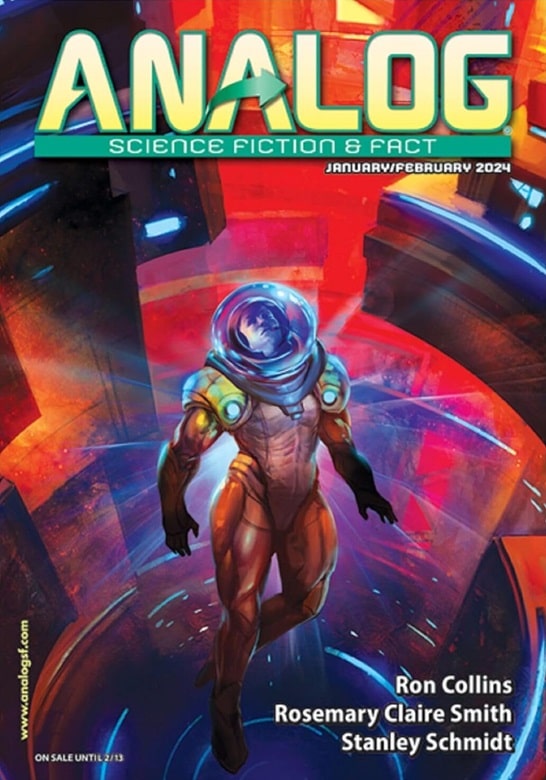 |
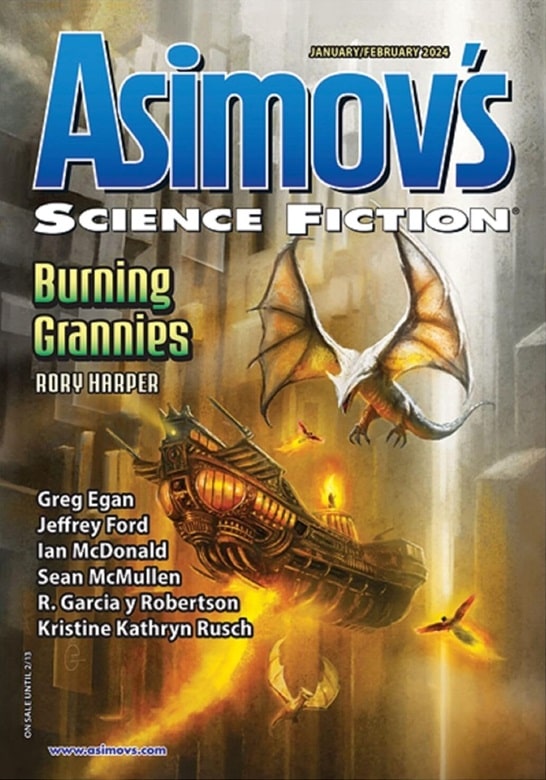 |
January-February 2024 issues of Analog Science Fiction & Fact and Asimov’s Science Fiction.
Cover art by Julie Dillon, and Maurizio Manzieri (for “Burning Grannies”)
It’s February 10th, and I’m a little concerned to see there’s no sign of the January/February issue of The Magazine of Fantasy & Science Fiction. Not on their website or Facebook Page, both of which still show the November-December issue, and not on Twitter/X or Amazon. I can’t even find a copy of the cover, which I usually receive from publisher Gordon Van Gelder. The only news I can find online is from Sam Tomaino, who shares this Note From the Publisher (and an advance review) in his excellent Zines & Short Fiction column at SFRevu.
Due to a set of unfortunate circumstances, this Jan/Feb 2024 issue was delayed by more than a month. For the sake of our newsstand readers, we re-named the issue “Winter 2024.” Subscribers should not worry about being shorted an issue.
Fingers crossed this is just a temporary glitch. In the meantime, I’m enjoying the new issues of Analog and Asimov’s Science Fiction, both of which are packed with intriguing new fiction from Kristine Kathryn Rusch, Greg Egan, R. Garcia y Robertson, Sean McMullen, Jeffrey Ford, Ian McDonald, Rory Harper, Michael Cassutt, Stanley Schmidt, Robert Friedman and Barry N. Malzberg, Martin L. Shoemaker, Raymund Eich, and lots more. See all the details below.
Let’s start with an excerpt from Sam’s review of the extremely-hard-to-find Winter issue of F&SF.
“The Wizzzer” by Scott Nicolay
A gang of kids has to deal with a dangerous toy that has started to eat people. Wonderfully strange.
“The Body-Part Woman” by Bonnie Elizabeth
Our narrator has a shop in which she sells body parts. Her special talents help her in business. Imaginative tale.
“How to Care for Your Domestic God” by Clara Madrigano is a novelet.
David and Beatriz, move to a house in suburban Philadelphia. It seems perfect, too perfect. Beatriz is an immigrant from Brazil and carries a box with her that contains photographs, journals, and other memorabilia of the women in her family, now deceased; her mother, grandmother, great aunts, great grandmother.
After they have lived in the house for a while, a figure appears to Beatriz first and, then, to both of them. It says it is the god of the house. It has been making things nice for them but it must be fed. What that means is a bit difficult to determine, but raw meat and blood seem to suffice but things are still difficult for them.
It all leads to a climax that makes this a great story.
“Big Trouble in Sector C” by Robert Friedman and Barry N. Malzberg
Murphy is uploaded into the network to search out and destroy malware. Things get complicated when he splits into Murphy One and Murphy Two. Then, he finds out Astrid, an old enemy, is behind it all. How will this turn out? Great story with a lot of twists and turns!
“The Interspatial Accessibility Compact’s Guidelines for Cross-Cultural Engagement” by Dane Kuttler
The owner of a flower shop on a space station wants to help people of two species come together. Charming.
The fiction concludes with “Do Not Hasten to Bid Me Adieu” by Will McMahon.
Hal is working for the WPA in 1937 New York City. His son, Charlie, is off fighting with the Lincoln Brigade in the Spanish Civil War. His daughter, Helen, is married with a son and living in San Francisco. One night a curious letter arrives in his mailbox with no stamp. It is from Princess Inanna Umma Ninsun of the Empire of Orion some thousands of years in the future. She says she is a descendant of his and is asking his advice. Her father wants to marry her off to an old man who is the Patriarch of the Central Persean Proctorate and she is not happy about it. They begin a correspondence.
Great story with a perfect ending.
Read Sam’s complete review here.
Mina discusses the latest Asimov’s at Tangent Online.
In “Proof of Concept” by Kristine Kathryn Rusch, detective Orli must solve a murder before the cruise ship reaches its First Disembarkation Point in less than 36 hours. Orli discovers quite quickly that there is no actual dead body lying there, just a simulation that fools the sensors. Orli investigates using her own independent computer system in her quarters. She finds out that the “victim” is a crew member, Riley Kalb, who was allowed to interact with passengers. Orli realises that she herself interacted with Kalb in an earlier case… Agatha Christie meets interstellar travel.
“Death and the Gorgon” by Greg Egan was also a very good detective story. We follow the Sheriff, Beth, as she investigates the death of a security guard. What I particularly liked is that the story got increasingly complex without straining the reader. There was an excellent look at fanaticism and how it can be harnessed by the unscrupulous in the main story line. The side story was also very thought-provoking with the Deputy, Ken, relying too much on the advice of an AI, Sherlock. An AI has no moral compass and it was refreshing to see that demonstrated so clearly here. My favourite story in this issue.
“Lucifer’s Lode” by R. Garcia y Robertson has Sherlock Holmes and Dr Watson visiting Tombstone. They are assisted by two female outlaws, Amanda “Little Britches” and Lisa Dalton. The title of the story refers to a silver compound (silver and lead with gold and platinum impurities). Amanda is shot in the back and wakes up… in Realtime on a spaceship orbiting Jupiter’s moon Europa. She was in a virtual world, part of a gaming site, and death in the game means loss of all winnings, which is why Lisa called time out to freeze the game. In Realtime, Amanda (the commander) and Lisa (her intelligence officer) are space pirates in a war-torn system and Lucifer is a lost, solid silver asteroid…. It’s a lively and well-written tale…
“It Goes So Fast” by Lisa Papademetriou is a subtle comment on getting so lost in the past, you aren’t really in the present any more; you become an observer of your own life rather than a participant. The protagonist of this tale is a young mother trying to increase her living space for herself and her baby son. She is clearly addicted to her “Memodex” that lets her re-live past moments in her head. She does not even notice that she is neglecting her son and fails to heed the warning about the future in her young neighbour’s suicide. This is a tale written with finesse, making it harder hitting.
“Burning Grannies” by Rory Harper is a curious, oddly beautiful story. Don’t let the title put you off, it’s not at all what you think it will be. We enter a world in which the protagonist Serafina collects what you come to suspect are the souls of the dead. These souls will eventually pass on to somewhere else — where we do not know. You also come to suspect that Serafina and her crew are the guardians of this underworld. A new soul who burns bright arrives, Gloria. She and Serafina are different — angels perhaps? Have a read and see what conclusions you come to.
Read Mina’s complete review here.
The always reliable Victoria Silverwolf, one of my favorite Tangent reviewers, has a look at the new Analog.
With no less than nineteen original works, and with settings ranging from the past to the near future to millennia from now, this issue is sure to offer something for every reader of science fiction.
The protagonist of “Sluggish” by Martin L. Shoemaker works gathering valuable material on an alien planet inhabited by giant slug-like creatures. Her vehicle gets stuck in the world’s swampy environment, leading to a struggle to survive. Despite the main character’s serious dilemma, there is a tongue-in-cheek tone to the story. The dialogue is informal and full of wisecracks. The planet’s ecosystem is intriguing, but the lighthearted mood creates little suspense.
“Places You Have Never Been” by David Cleden involves invisible but solid bubbles that appear, seemingly at random, in a city. When they vanish, they take whatever is inside them along. A young man assists an older man in mapping these bubbles, partly to help curious onlookers avoid the danger, and partly to understand their behavior. The arrival of a young woman who has her own motive leads to a dramatic conclusion. The story is expertly plotted, with a flashback early in the text proving to be relevant to the climax in a surprising but logical way. The premise is interesting and the characters are fully developed.
“For Every Bee, a Hive” by Benjamin C. Kinney takes place at a time in the future when artificial intelligences are hostile to human beings. The protagonist is aboard a spaceship, out to salvage damaged AI devices near Neptune, in order to supply a human colony on the moon Nereid. The place of salvage turns out to be infested with a deadly weapon. The main character’s survival depends on reactivating a small AI found in the area, with all the risk that entails…
The main characters in “Hull Run” by David Goodman are adolescents living in a gigantic airship floating high in the atmosphere of Venus. They amuse themselves by running a dangerous race from one end of the outside of the huge vessel to the other. Unusually heavy winds make this particular race even more hazardous than usual, leading to a battle for survival. The author does a fine job depicting believable young people. The setting is vivid, and the race that goes wrong creates genuine suspense…
The protagonist of “You’re 16” by Steve Ingeman is a teenage girl who undergoes a procedure that makes her part of a powerful computing system. Although she becomes something much more than an ordinary human being, she is drawn back into her former life. The way in which the author depicts the main character’s enhanced mind is awe-inspiring. Rarely has superintelligence been described in such a sublime way. The story has an ending that carries quite an impact.
“Tepid War” by Jay Werkheiser takes place in a near future when advanced military technology makes civilians safe, even when battles are taking place all around them. Weapons attack only military targets with perfect precision. Civilians may be inconvenienced by traffic jams and the like as side effects, but they put up with these annoyances. The plot deals with office politics against this background. This is a bitingly satiric tale, in which typical American corporation workers worry about ordinary problems at their jobs while the nation is at war with Russia, China, and India. They fight for parking spaces while military drones attack each other…
Read Victoria’s complete review here.
Here’s all the details on the latest SF print mags.
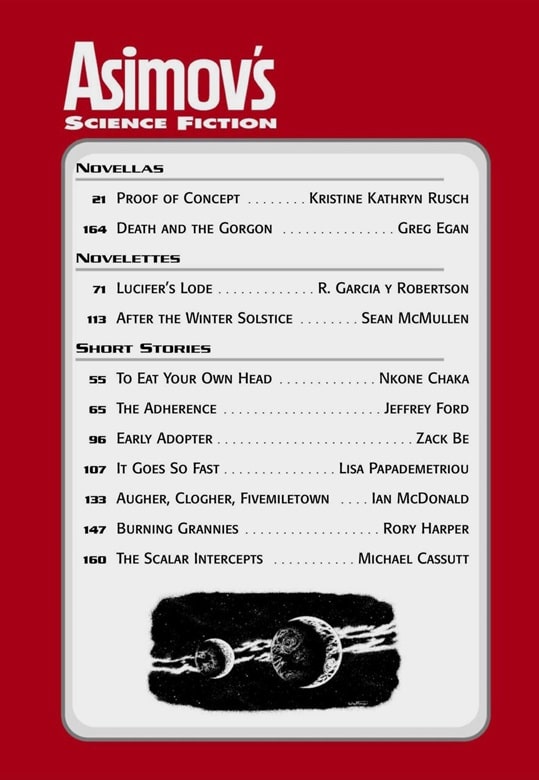 |
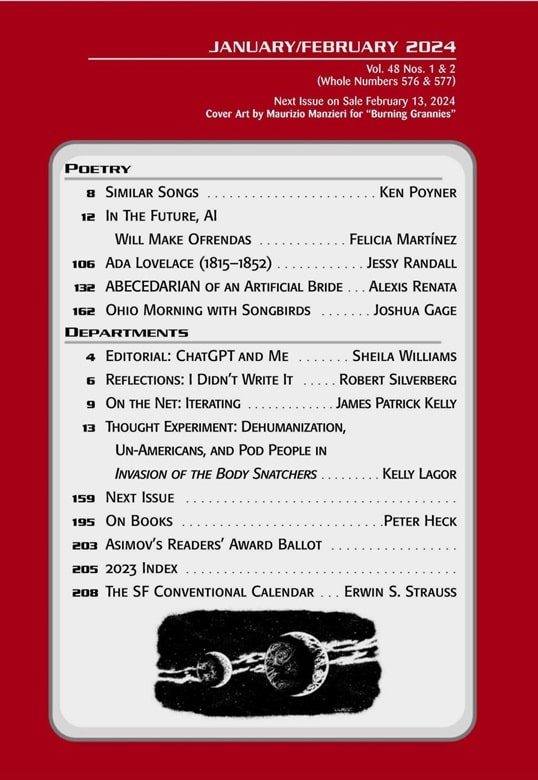 |
Contents of the January-February 2024 issue of Asimov’s Science Fiction
Asimov’s Science Fiction
Read Sheila’s summary of the latest issue of Asimov’s at the website.
Here’s the complete Table of Contents.
Novellas
“Proof of Concept” by Kristine Kathryn Rusch
“Death and the Gorgon” by Greg Egan
Novelette
“Lucifer’s Lode” by R. Garcia y Robertson
“After the Winter Solstice” by Sean McMullen
Short Stories
“To Eat Your Own Head” by Nkone Chaka
“The Adherence” by Jeffrey Ford
“Early Adopter” by Zack Be
“It Goes So Fast” by Lisa Papademetriou
“Augher, Clogher, Fivemiletown” by Ian McDonald
“Burning Grannies” by Rory Harper
“The Scalar Intercepts” by Michael Cassutt
Poetry
Similar Songs by Ken Poyner
In The Future, AI Will Make Ofrendas by Felicia Martínez
Ada Lovelace (1815–1852) by Jessy Randall
ABECEDARIAN of an Artificial Bride by Alexis Renata
Ohio Morning with Songbirds by Joshua Gage
Departments
Editorial: ChatGPT and Me by Sheila Williams
Reflections: I Didn’t Write It by Robert Silverberg
On the Net: Iterating by James Patrick Kelly
Thought Experiment: Dehumanization, Un-Americans, and Pod People in Invasion of the Body Snatchers by Kelly Lagor
Next Issue
On Books by Peter Heck
Asimov’s Readers’ Award Ballot
2023 Index
The SF Conventional Calendar by Erwin S. Strauss
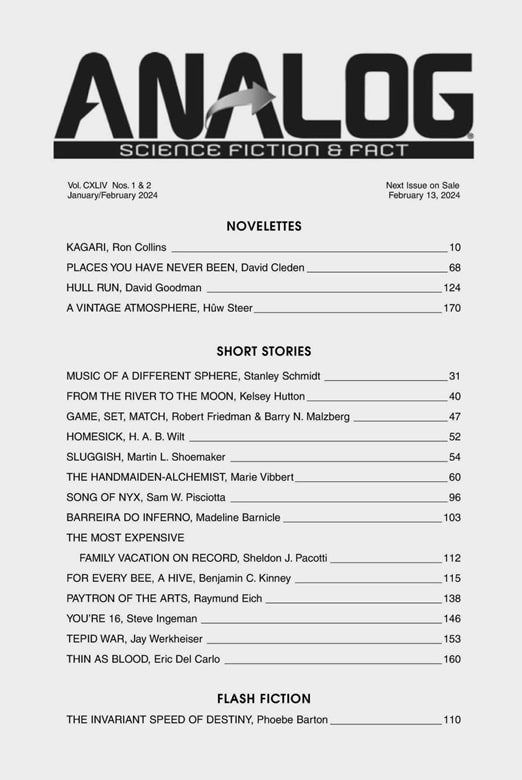 |
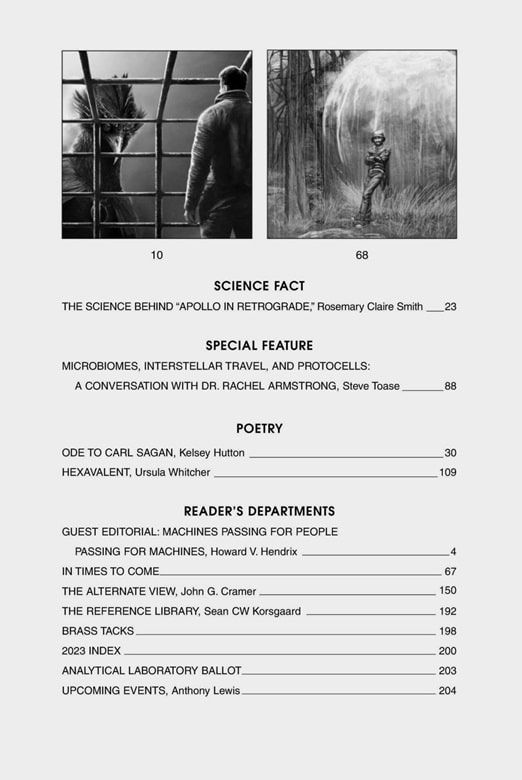 |
Contents of the January-February 2024 issue of Analog Science Fiction
Analog Science Fiction & Science Fact
Editor Trevor Quachri gives us a tantalizing summary of the current issue online, as usual.
Here’s the full TOC.
Novelettes
“Kagari” by Ron Collins
“Places You Have Never Been” by David Cleden
“Hull Run” by David Goodman
“A Vintage Atmosphere” by Hûw Steer
Short Stories
“Music of a Different Sphere” by Stanley Schmidt
“From the River” to the Moon by Kelsey Hutton
“Game, Set, Match” by Robert Friedman & Barry N. Malzberg
“Homesick” by H.A.B. Wilt
“Sluggish” by Martin L. Shoemaker
“The Handmaiden-Alchemist” by Marie Vibbert
“Song of Nyx” by Sam W. Pisciotta
“Barreira do Inferno” by Madeline Barnicle
“The Most Expensive Family Vacation on Record” by Sheldon J. Pacotti
“For Every Bee, a Hive” by Benjamin C. Kinney
“Paytron of the Arts” by Raymund Eich
“You’re 16” by Steve Ingeman
“Tepid War” by Jay Werkheiser
“Thin As Blood” by Eric Del Carlo
Flash Fiction
“The Invariant Speed of Destiny” by Phoebe Barton
Science Fact
The Science Behind “Apollo in Retrograde” by Rosemary Clare Smith
Special Feature
Microbiomes, Interstellar Travel, and Photocells: A Conversation with Dr. Rachel Armstrong by Steve Toase
Poetry
Ode to Carl Sagan by Kelsey Hutton
Hexavalent by Ursula Whitcher
Reader’s Departments
Guest Editorial: Machines Passing for People Passing for Machines by Howard V. Hendrix
In Times to Come
The Alternate View by John G. Cramer
The Reference Library by Sean CW Korsgaard
Brass Tacks
2023 Index
Analytical Laboratory Ballot
Upcoming Events by Anthony Lewis
The Magazine of Fantasy & Science Fiction
F&SF’s editor is Sheree Renée Thomas. There’s no details on the magazine at any of my usual sources, but fortunately Sam Tomaino shared the Table of Contents at SFRevu.
Here’s the Table of Contents.
Novelets
“How to Care for Your Domestic God,” by Clara Madrigano
Short Stories
“what kills the stars” by Alex Bisker
“The Ndayaan Sea” by Moustapha Mbacké Diop
“The Icy Wasteland at Her Feet” by Deborah L. Davitt
“Guilt Can Wilt the Sweetest Flower” by Veronica Henry
“Mackson’s Mardi Gras Moon Race” by David DeGraff
“The Wizzzer” by Scott Nicolay
“Burned Like Coal” by T.R. Napper
“The Diamond Factory” by Phoebe Barton
“The Body-Part Woman” by Bonnie Elizabeth
“Big Trouble in Sector C” by Robert Friedman and Barry N. Malzberg
“All Our Better Angels” by Jack Neel Waddell
“Puzzle Pieces” by Jennifer R. Povey
“Zariel: Parable of a Gifted Black Child” by Denzel Xavier Scott
“The Wounded King” by J.A. Prentice
“The Interspatial Accessibility Compact’s Guidelines for Cross-Cultural Engagement” by Dane Kuttler
“Do Not Hasten to Bid Me Adieu” by Will McMahon
Poems
Sea and Sky by Meagan Branning
A Selection of Book Curses by Meagan Branning
Cities Through Telescopes by Richard Leis
Vanishing Act by Avra Margariti
Departments
Editorial: Shifting Light by Sheree Renée Thomas
Books to Look For by Charles de Lint
Musing on Books by Michelle West
Television: The Ugly Humanity of The Boys by Karin Lowachee
Science: The World’s Greatest Telescopes by Jerry Oltion
Coming Attractions
Curiosities by Paul Di Filippo
Art
Cartoons by: Arthur Masear, Lynn Hsu
Cover by Mondolithic Studios
Analog, Asimov’s Science Fiction and The Magazine of Fantasy & Science Fiction are available wherever magazines are sold, and at various online outlets. Buy single issues and subscriptions at the links below.
Asimov’s Science Fiction (208 pages, $8.99 per issue, one year sub $55.90 in the US) — edited by Sheila Williams
Analog Science Fiction and Fact (208 pages, $8.99 per issue, one year sub $55.90 in the US) — edited by Trevor Quachri
The Magazine of Fantasy & Science Fiction (256 pages, $10.99 per issue, one year sub $65.94 in the US) — edited by Sheree Renée Thomas
The January-February issues of Asimov’s and Analog are on sale until February 13. See our coverage of the November-December issues here, and all our recent magazine coverage here.
Thanks for the update, John. I had visited three local Barnes & Nobles in a search for that issue. Hopefully it is really delayed and not worse. Though it is still an excellent magazine, the circulation figures are pretty abysmal.
F&SF seems to be having a problem getting name authors. I tend not to be a issue of a magazine when the majority if not all of the authors are unknown to me. Asimov’s seems to betting a lot of name writers.
Steve,
I don’t think F&SF has trouble getting name authors — it’s still a highly desirable market, despite some of its recent troubles. But I do think editor Sheree Renée Thomas is trying hard to attract new talent. I’ve been very intrigued by what she’s accomplished so far, and I’m excited to see what new authors she can attract to the magazine over the next few years.
Chuck,
I’ve watched the cover price of F&SF increase from $7.99 in 2016 to $10.99 today, making it by far the most expensive of the digests. It’s well worth the price, and I hoped that would put it on more stable footing from a profitability standpoint. I guess we’ll see.
Surprisingly, I just picked up the March / April issues of Analog and Asimov’s yesterday at my local B&N.
Lou,
Yeah, I try and get these articles out while the magazines are still on the shelves…. but it’s a tough balancing act when one mag is two months late, and the other two are pulled from the shelves a week before the on-sale date of the new issue!
Ah well. We cope as best we can. 🙂
I received the following email from F&SF publisher Gordon Van Gelder this morning.
“The short answer is that we were running late with the Jan/Feb issue (due to personal and personnel issues) when our printer abruptly informed us they would no longer do our printing.
After much scrambling, we’ve found a new printer and the Jan/Feb issues—now titled “Winter 2024”—are on press and will be shipping soon.
I decided not to post this info on your Facebook page because I can’t afford to spend all day in an online discussion, but you’re welcome to pass along the info.”
While I’m bummed to hear about their printer issues, I’m very relieved to hear the magazine has weathered them with no more than a slight delay. Kudos to Gordon and his whole team for minimizing impact for readers.